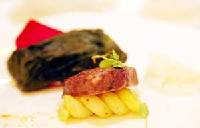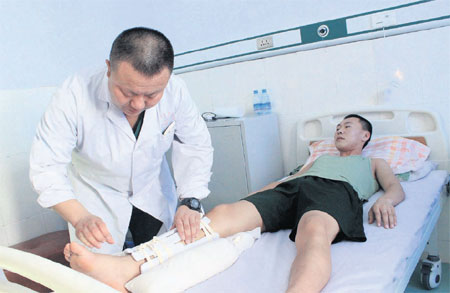Mongolian medicine and its healers
|
A practitioner of traditional Mongolian medicine helps a patient in Tongliao, a city which has become one of the most important hubs for this medical tradition. Photos by Wang Kaihao / China Daily |
 |
| Seasonal flu prevention tips |
 |
| Healthy Spring Festival recipes in flu season |
Xu Jinfeng was visiting her son in northeastern China, having traveled from her native Zhejiang province, when the unexpected happened. She fractured her left knee. Xu was resigned to spending the Spring Festival in a strange hospital far from home and was not looking forward to what she believed would be a long and painful recuperation.
Fortunately, she was admitted to a specialist orthopedic hospital in Horqin Left Wing Rear Banner of Tongliao, an eastern city in the Inner Mongolia autonomous region.
Her orthopedist is Bao Rong, 49, an ethnic Mongolian bone-setting practitioner, the fourth generation in her family to practice the art.
Three weeks after Xu's accident, she waits in her ward while Bao approaches her bedside. Bao takes a mouthful of white spirits, and sprays the alcohol on Xu's knee and follows up with a massage.
"White spirits will relieve pain during rehabilitation," Bao says. "The spraying is also a crucial process before the operation, because it will calm patients when their bones hurt. Although we have more modern ways to do this, we still keep this tradition because there are reasons why our ancestors have used this ancient method since shamanistic times."
The "operation" Bao refers to may only last 60 seconds, usually a day after the patient is admitted.
Traditional Mongolian bone-setting practitioners will repair the fractures with only their bare hands, and use splints of wood and fur to help the recuperation process.
Without the stainless steel pins commonly used in Western orthopedic surgery, it takes a shorter time for patients to heal. Xu is expected to go home at the end of January, and her hospital bill will be about 15,000 yuan ($2,480), about half of what she may pay if she had submitted to conventional surgery."The elderly are prone to breaking their hips, for example. The typical treatment would be to replace the broken bones with artificial parts, which can be expensive. We have already had many successful cases through our traditional methods."
Mongolian bone setting was named one of China's national intangible cultural heritages in 2011. It is only a branch of traditional Mongolian medicine practiced for many centuries, but relatively unknown outside the Mongolian communities.
Related: Healing traditions go abroad

















